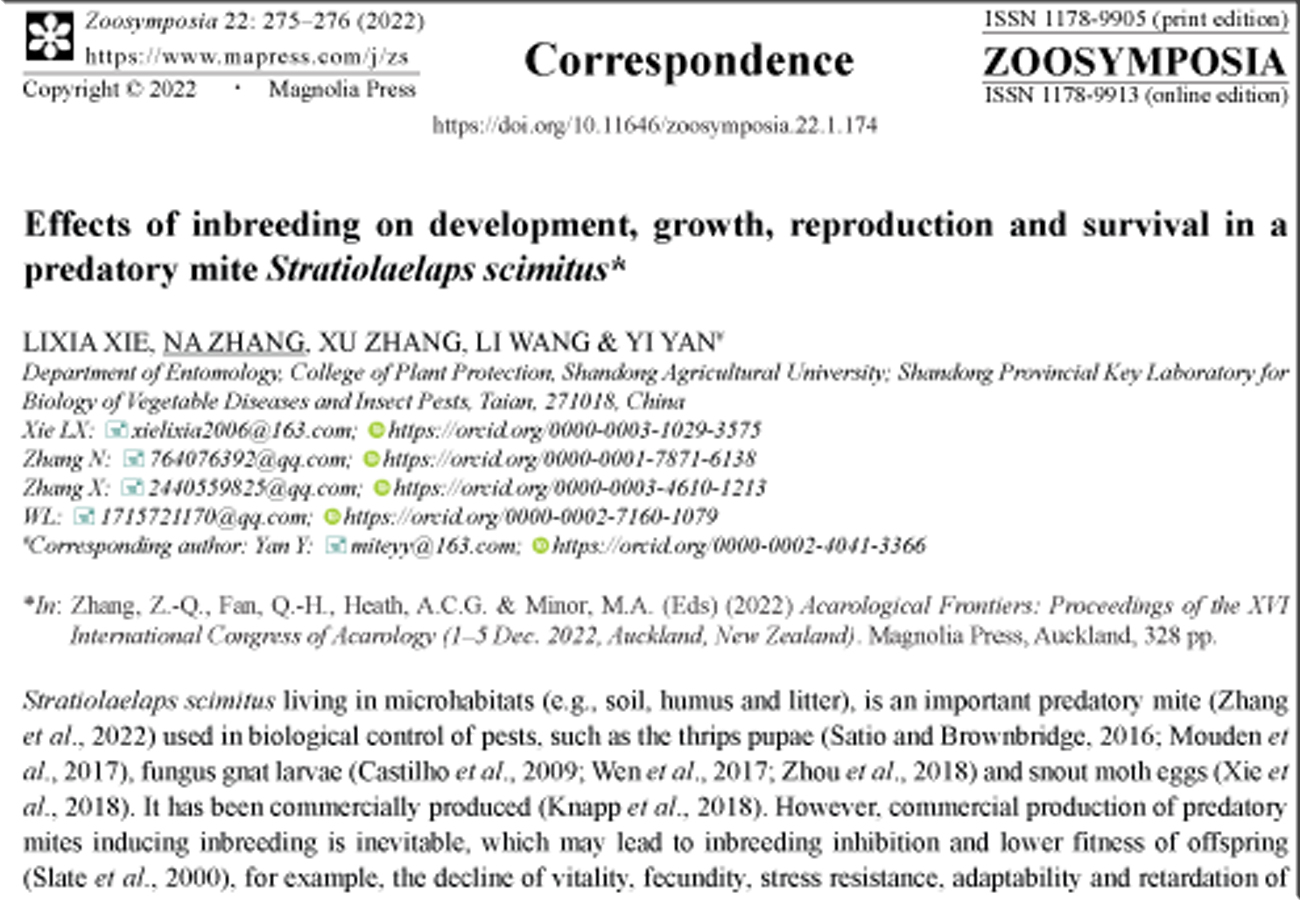Abstract
Stratiolaelaps scimitus living in microhabitats (e.g., soil, humus and litter), is an important predatory mite (Zhang et al., 2022) used in biological control of pests, such as the thrips pupae (Satio and Brownbridge, 2016; Mouden et al., 2017), fungus gnat larvae (Castilho et al., 2009; Wen et al., 2017; Zhou et al., 2018) and snout moth eggs (Xie et al., 2018). It has been commercially produced (Knapp et al., 2018). However, commercial production of predatory mites inducing inbreeding is inevitable, which may lead to inbreeding inhibition and lower fitness of offspring (Slate et al., 2000), for example, the decline of vitality, fecundity, stress resistance, adaptability and retardation of growth.
References
Castilho, R.C., Moraes, G.J. & de Silva, E.S. (2009) The predatory mite Stratiolaelaps scimitus as a control agent of the fungus gnat Bradysia matogrossensis in commercial production of the mushroom Agaricus bisporus. International Journal of Pest Management, 55 (3), 181–185. https://doi.org/10.1080/09670870902725783
Knapp, M., Houten, Y.V., Baal, E.V. & Groot, T. (2018) Use of predatory mites in commercial biocontrol: current status and future prospects. Acarologia, 58 (Suppl), 72–82. https://doi.org/10.24349/acarologia/20184275
Mouden, S., Sarmiento, K.F., Klinkhamer, P.G.L. & Leiss, K.A. (2017) Integrated pest management in western flower thrips: Past, present and future. Pest Management of Science, 73 (5), 813–822. https://doi.org/10.1002/ps.4531
Saito, T. & Brownbridge, M. (2016) Compatibility of soil-dwelling predators and microbial agents and their efficacy in controlling soil-dwelling stages of western flower thrips Frankliniella occidentalis. Biological Control: Theory and Application in Pest Management, 92, 92–100. https://doi.org/10.1016/j.biocontrol.2015.10.003
Slate, J., Kruuk, L.E., Marshall, T.C., Pemberton, J.M. & Clutton-Brock, T.H. (2000) Inbreeding depression influences lifetime breeding success in a wild population of red deer (Cervus elaphus). Proceedings Biological Sciences, 267 (1453), 16–17. https://doi.org/10.1098/rspb.2000.1192
Wen, M.F., Chi, H., Lian, Y.X., Zheng, Y.H., Fan, Q.H. & You, M.S. (2017) Population characteristics of Macrocheles glaber (Acari: Macrochelidae) and Stratiolaelaps scimitus (Acari: Laelapidae) reared on a mushroom fly Coboldia fuscipes (Diptera: Scatopsidae). Insect Science, 26 (2), 322–332. https://doi.org/10.1111/1744-7917.12511
Xie, L.X., Yan, Y. & Zhang, Z.Q. (2018) Development, survival and reproduction of Stratiolaelaps scimitus (Acari: Laelapidae) on four diets. Systematic and Applied Acarology, 23 (4), 779–794. https://doi.org/10.11158/saa.23.4.16
Zhou, C.Y., Zhang, Q., Li, Y.Y., Yan, Y. & Xie, L.X. (2018) Functional response of Stratiolaelaps scimitus to Bradysia odoriphaga. Chinese Journal of Applied Entomology, 55 (4), 705–710. https://doi.org/10.7679/j.issn.2095-1353.2018.088
Zhang, N., Liu, X.Y., Lu, W.Z., Tan, Y.Y., Xie, L.X. & Yan, Y. (2022) How long do laelapid mites (Acari: Mesostigmata: Laelapidae) live? Zoosymposia, 21, 37–56.


